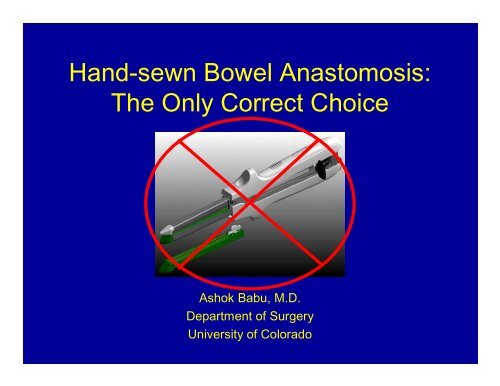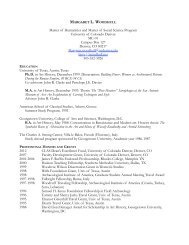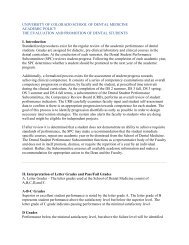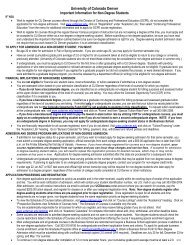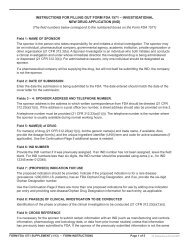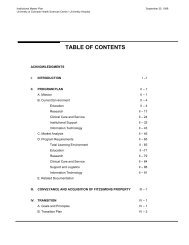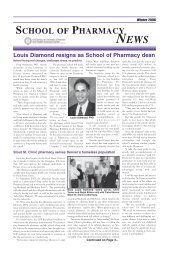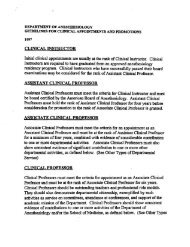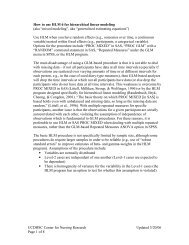Hand-sewn Bowel Anastomosis - University of Colorado Denver
Hand-sewn Bowel Anastomosis - University of Colorado Denver
Hand-sewn Bowel Anastomosis - University of Colorado Denver
You also want an ePaper? Increase the reach of your titles
YUMPU automatically turns print PDFs into web optimized ePapers that Google loves.
<strong>Hand</strong>-<strong>sewn</strong> <strong>Bowel</strong> <strong>Anastomosis</strong>:<br />
The Only Correct Choice<br />
Ashok Babu, M.D.<br />
Department <strong>of</strong> Surgery<br />
<strong>University</strong> <strong>of</strong> <strong>Colorado</strong>
• History<br />
Outline<br />
• Trial data in specific applications<br />
– Colorectal<br />
– Ileocolic<br />
– Esophagogastric<br />
– Trauma<br />
• Time efficiency<br />
• Cost efficiency
History<br />
• Sutureless anastomosis (compression)<br />
– 1826: Donaus<br />
• <strong>Hand</strong>-<strong>sewn</strong> double layer<br />
– 1882: Connel<br />
• <strong>Hand</strong>-<strong>sewn</strong> single layer<br />
– 1887 Halsted, 1922 Schiassi, 1951 Gambee, 1975<br />
Matheson<br />
• Stapled<br />
– 1908—Hungary—Hultl<br />
– Early 1960’s—Moscow<br />
– Late 1960’s—USA—Ravitch
The Controversy
Colorectal—Meta-analysis<br />
Complication<br />
• 13 PRCT comparing hand<strong>sewn</strong> vs stapled<br />
Leak<br />
• No study independently showed significant<br />
Mortality 1.27<br />
0.55-2.93<br />
difference in leak rate, stricture, cancer<br />
Stricture 3.12<br />
1.28-7.56<br />
recurrence, or mortality<br />
Tech Problem<br />
Cancer rec.<br />
Wound infection<br />
15<br />
1.3<br />
1.02<br />
MacRae et. al. Dis Colon Rectum 1998.<br />
Odds Ratio<br />
1.09<br />
Conf. Interval<br />
0.78-1.52<br />
4.6-49<br />
0.57-3.04<br />
0.53-1.98<br />
ODDS RATIO LESS THAN 1 FAVORS STAPLED ANASTOMOSIS
Colorectal—Meta-analysis<br />
•Complication Cochrane Review—9 Stapled PRCT. Sewn 1233 patient CI<br />
– 622 stapled<br />
Leak<br />
– 611 hand<strong>sewn</strong><br />
6.3%<br />
Mortality 2.4% 3.6% NS<br />
• Indications included cancer, diverticulosis,<br />
Stricture prolapse 8% 2% 1.2%-<br />
8.1%<br />
• Mostly EEA but some end to side<br />
Wound infection<br />
5.9% 4.3% NS<br />
Lustosa et. al. Cochrane Database. 2001.<br />
7.1%<br />
NS
Colorectal—Summary<br />
• No difference between stapled vs.<br />
hand<strong>sewn</strong> except for:<br />
– higher stricture and technical mishap rate in<br />
stapled<br />
– Average <strong>of</strong> 8 minutes longer time for<br />
hand<strong>sewn</strong> (from one study)
Ileocolic<br />
• Very few trials<br />
• Largest PRMCT by Kracht et. al.<br />
• 440 patients—RADIOLOGIC leak detection<br />
• Randomized to side/side stapled (106) or 4<br />
types <strong>of</strong> sutured<br />
– End to end interrupted/continuous (84/77)<br />
– End to side interrupted/continuous (82/91)<br />
• 8.3% leak rate in all hand<strong>sewn</strong> groups vs 3%<br />
stapled<br />
• Not significant in subgroups<br />
Kracht et. al. Int J Colorectal Dis. 1993
Ileocolic—Crohn’s<br />
• Retrospective study End to End<br />
• Wide lumen side to side stapled (69) compared<br />
to <strong>Hand</strong><strong>sewn</strong> end to end (69)<br />
• Stricture/fistula<br />
Hypothesis: wide lumen 26% leads to less 4% stasis, p=.017<br />
pressure, and ischemia resulting in lower leak,<br />
stricture , and recurrence rates<br />
Recurrence<br />
Munoz-Juarez. Dis Col Rectum. 2001<br />
57%<br />
Wide side/side<br />
24% p=.04
• Retrospective study<br />
Ileocolic—Crohn’s<br />
• Wide lumen side to side stapled (71) compared<br />
to <strong>Hand</strong><strong>sewn</strong> end to end (55)<br />
• Leak Rate 14.1% end to end vs 2% (p=0.02)<br />
Resegotti. Dis Col Rectum. 2005.
Ileocolic—Summary<br />
• These studies compare anastomotic<br />
configuration AND stapled vs. hand<strong>sewn</strong><br />
technique simultaneously<br />
• This makes the data uninterpretable
Esophagogastric anastomosis<br />
• Meta-analysis 5 PRCT’s<br />
• Circular stapler vs. end-end hand-<strong>sewn</strong><br />
• All patients underwent esophagectomy for<br />
cancer and randomized to 2 techniques<br />
• No significant difference in leak or stricture<br />
rate, though trend in favor <strong>of</strong> hand-<strong>sewn</strong><br />
• RR Mortality 0.45 in hand-<strong>sewn</strong> (p=0.05)
Trauma Suture is better<br />
• Retrospective cohort—Harborview, Seattle<br />
• Small bowel and large bowel, blunt and penet.<br />
• Hypothesis: bowel edema in trauma renders<br />
fixed depth staple dangerous<br />
• Looked for clinically significant leaks<br />
n<br />
Leak<br />
IAA<br />
Fistula<br />
Brundage et. al. JOT 1999<br />
Stapled<br />
58<br />
4 (7%)<br />
6 (10%)<br />
1<br />
Sewn<br />
60<br />
0<br />
2 (3%)<br />
1<br />
p<br />
.04<br />
.13
Trauma Suture is better<br />
• Retrospective multicenter<br />
• Small bowel and large bowel, blunt and penet.<br />
n<br />
Leak<br />
IAA<br />
Fistula<br />
Brundage et. al. JOT 2001<br />
Stapled<br />
175<br />
7<br />
19<br />
3<br />
Sewn<br />
114<br />
0<br />
4<br />
2<br />
p<br />
.04<br />
.04<br />
NS
Trauma No Difference<br />
• Retrospective cohort—Minnesota group<br />
• Small bowel injury only, blunt and penet.<br />
• Compared resections with hand<strong>sewn</strong> vs. stapled<br />
reconstruction<br />
n<br />
Leak<br />
IAA<br />
Fistula<br />
Witzke et. al. JOT 2000<br />
Stapled<br />
110<br />
0<br />
11<br />
2<br />
Sewn<br />
34<br />
3<br />
15<br />
0<br />
p<br />
NS<br />
NS<br />
NS
Trauma No Difference<br />
• Prospective multicenter nonrandomized<br />
• Penetrating colon injuries<br />
• Leaks defined as req. draining or operation<br />
n<br />
Infection<br />
IAA<br />
Leak<br />
Mortality<br />
Stapled<br />
79<br />
26.6%<br />
20.3%<br />
6.3%<br />
3.8%<br />
Demetriades, Moore et. al. JOT 2002<br />
Sewn<br />
128<br />
20.3%<br />
15.6%<br />
7.8%<br />
3.1%<br />
p<br />
0.3<br />
0.39<br />
0.69<br />
0.8
• Shape<br />
• Technique<br />
• Technical<br />
• Location<br />
• Indication<br />
Heterogeneity<br />
Stapled<br />
<strong>Hand</strong><strong>sewn</strong><br />
End-to-End<br />
End-to-Side<br />
Side-to-Side<br />
Circular<br />
Linear<br />
Continuous<br />
Interrupted<br />
Tension<br />
Blood Supply<br />
Technical execution<br />
Esophagus<br />
Stomach<br />
Small bowel<br />
Large bowel<br />
Cancer<br />
IBD<br />
Trauma<br />
Infection<br />
2 nd layer<br />
No reinforcement<br />
Single Layer<br />
Double Layer
1 st Author<br />
George<br />
Didolkar<br />
McGinn<br />
Scher<br />
Adl<strong>of</strong>f<br />
Operative Time<br />
Design<br />
PRCT<br />
PRCT<br />
PRCT<br />
PNRT<br />
Retro<br />
n<br />
1004<br />
88<br />
118<br />
242<br />
51<br />
Stapled<br />
(min)<br />
104<br />
170<br />
115<br />
148<br />
180<br />
Sewn<br />
(min)<br />
116<br />
154<br />
122<br />
163<br />
176
Single surgeon experience<br />
Bruno Cola, Bologna, Italy
Cola. It. J Coloproct. 2004<br />
Cost Analysis (Euros)
Cola. It. J Coloproct. 2004<br />
Cost Analysis (Euros)
Conclusion<br />
• No solid evidence for improved outcomes<br />
or decreased operative times with stapled<br />
anastomosis <strong>of</strong> any type<br />
• In an era <strong>of</strong> morbidly expensive<br />
healthcare, the use <strong>of</strong> staplers for GI<br />
anastomosis should ONLY be considered<br />
in the setting <strong>of</strong> special circumstance<br />
(laparoscopy, etc.)


